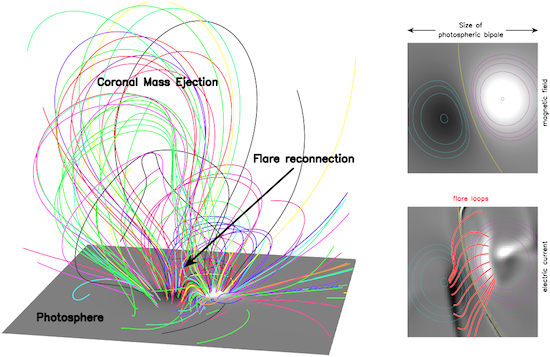Solar flares strongly affect not only the Sun’s atmosphere, but also Earth’s environment. Thus, quantifying the maximum possible energy of present-day eruptions is a key question for astrophysics and for its applied branch of space weather. The largest solar flares observed over the past few decades have reached energies of a few times 1025 Joules, possibly up to 1026. But super flares in active Sun-like stars reach up to about 1029 Joules. In the absence of direct observations, up to now, of solar flares within this range, complementary methods of investigation are needed to assess the probability of solar flares beyond those in the observational record.
A team composed of five researchers at Observatoire de Paris and a member of Lockheed Martin Advanced Technology Center has been able to relate the energy of solar flares to the area of the sunspot group from which they originate. To do so, they combined the most realistic numerical magneto-hydrodynamic simulation for solar eruptions, with more than one century of historical recordings of sunspots and active regions coming from daily observations made at Meudon site of Observatoire de Paris.
Strongest events
By considering the largest sunspot group ever reported (from April 1947), the team has predicted the value of the highest possible energy of solar flares. The result, thus obtained from observational and theoretical analyses, is about 6 x 1026 Joules. This is 600 millions of millions of millions of millions of Joules. Even though the number is impressive, it corresponds to the total radiative energy emitted by the Sun during two seconds only. This upper limit on the energy of solar flares is still ten times higher than the energy measured for the October 28, 2003 X17 class flare, which was a major space weather event. And it is six times higher than the one estimated for the November 4, 2003 X28-40 flare, which saturated every available sensors aboard space telescopes. This flare remains, to date, the strongest one ever observed with modern instrumentation. And it is presumably comparable to the Carrington flare from 1859.
One question not addressed in this work is whether or not the current solar convective dynamo can produce gigantic sunspot groups, as required to produce strong super flares according to the model. This seems unlikely, recall the astrophysicists authors of the study. In fact, such giant sunspot groups have not been recorded in four centuries of direct scientific observations and in millennia of sunrises and sunsets viewable by anyone around the world. It can thus reasonably be assumed that, during billion years around now, while on the main sequence of its life, the Sun never has produced - and never will produce - a flare more energetic than this maximum.
“All solar flares which have been reported thus far were below the upper limit”, says Guillaume Aulanier, astronomer at Observatoire de Paris, “nevertheless during the last 160 years, we have experienced several episodes of comparable magnitude. Each of these strong flares had significant consequences on Earth’s space environment and on our technologically evolved world. Predicting future similar events is therefore an important challenge. But definitively, there will be no Big One causing the end of world.”
These results will appear online on December 20, 2012, and in January 2013 issue of Astronomy & Astrophysics.
Collaboration
This study was conducted by Guillaume Aulanier, Pascal Démoulin, Miho Janvier, Etienne Pariat, Brigitte Schmieder at Observatoire de Paris and Carolus Schrijver at Lockheed Martin (Palo Alto, California). Isabelle Bualé, solar observer at Observatoire de Paris, digitalized the historical Meudon spectro-heliograph observations. They are available online in the BASS2000 database : bass2000.obspm.fr. The work of Miho Janvier was financed by the AXA research fund. The solar flare model was calculated on the cluster of the Division Informatique de l’Observatoire de Paris.
References
The standard flare model in three dimensions, II. Upper limit on solar flare energy, to appear in the January 2013 issue of Astronomy & Astrophysics.
http://dx.doi.org/10.1051/0004-6361/201220406
The standard flare model in three dimensions, I. Strong-to-weak shear transition in post-flare loops, published in the July 2012 issue of Astronomy & Astrophysics.http://dx.doi.org/10.1051/0004-6361/201219311
Estimating the frequency of extremely energetic solar events, based on solar, stellar, lunar, and terrestrial records, Carolus Schrijver and collaborators, published in the August 2012 issue of the Journal of Geophysical Research.
http://dx.doi.org/10.1029/2012JA017706
Images, videos, and animation



Click here to see the animation

Science contacts
Observatoire de Paris
Guillaume Aulanier
Astronomer
LESIA
+33 (0) 1 45 07 71 46
Miho Janvier
Post-doctoral researcher
LESIA
+33 (0) 1 45 76 59
miho.janvier chez obspm.fr
Press relations
Observatoire de Paris
Frédérique Auffret
+33 (0) 1 40 51 20 29
+33 (0) 6 22 70 16 44

